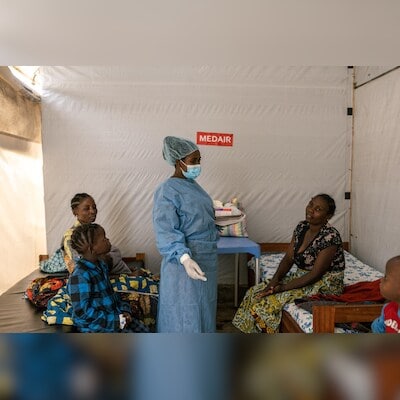According to WHO, Mpox is transmitted in multiple ways in Congo, including through close physical contact between people who engage in transactional sex | Photo: Bloomberg
As disease detectives race to central Africa to quell a spreading mpox contagion, they are finding a complex mosaic of infection patterns involving different viral strains and very different routes of infection.
In the gold-rich eastern region of the Democratic Republic of Congo, a newly mutated virus is spreading mainly among adults through sexual contact. Elsewhere in the country, an older strain is spreading from infected wildlife to humans who hunt and handle the animals, leading to a deadly explosion of cases among children. Both viral routes are linked to infections among patients’ household members and the health care workers who care for them.
The virus is spreading along international routes to neighbouring countries and there are reports that sexual violence is on the rise, especially among Congolese displaced by the conflict who live in crowded camps. Determining how the spread occurs is critical to stopping the transmission of an emerging disease that the World Health Organisation declared an international health emergency last week.
“There are huge gaps in knowledge and a huge need to fill them as quickly as possible,” said Margaret Harris, a WHO spokeswoman in Geneva. “One of the most urgent needs is to understand transmission patterns.”
Insufficient evidence
Researchers say diagnostic testing is lacking in Central Africa, as is the sophisticated genomic sequencing that helped scientists map and understand the spread of Covid-19 within communities.
According to WHO, Mpox is transmitted in multiple ways in Congo, including through close physical contact between people who engage in transactional sex. Infected people can also transmit the virus to their partners and health care workers.
Experts on the ground see no evidence of airborne spread, epidemiologists Anne Rimoin and Katelyn Jetelina said in an Aug. 20 blog post. Instead, they see potential routes of infection, such as children hunting rodents or four people sleeping in a bed.
Since the beginning of the year, there have been about 19,000 cases and nearly 550 deaths across Africa. Most of them have been in Congo, which recorded nearly three-quarters of the 1,405 new mpox cases on the continent in the week through Tuesday, according to data from the Africa CDC.
However, the true number is likely much higher because not all cases have been reported and few tests have been carried out. About 17 percent of Congo’s new cases were confirmed by testing and the rest fit the agency’s definition of the disease. Burundi has reported 100 cases and last week Sweden reported an initial infection in a traveler.
The strain that is proliferating in Africa, endemic to the Congo and historically more severe, is called clade I. Most cases in the Congo are subvariant Ia, which accounts for about 85 percent of deaths; about 80 percent of known clade Ia cases are in children. The second subvariant, Ib, is spreading among adults.
“Some of these emerging viruses we’re seeing are changing behavior and becoming more aggressive,” said Helen Rees, founder of the Reproductive Health and HIV Institute in Johannesburg. “We saw it with Ebola, we saw it with COVID, and now we’re seeing it with mpox.”
While understanding how different strains spread is vital, health officials say working with affected communities to explain the need for behavioral change is equally crucial.
It’s about time
“We need to tell children to refrain from eating meat from the bush or from animals found dead in the forest,” said Jean-Jacques Muyembe-Tamfum, a microbiologist who leads emergency health responses in the Democratic Republic of Congo. “This is the first step.”
The second is to stop person-to-person transmission by ensuring communities are aware of the need to wash their hands regularly and take precautionary measures when having sex, such as using condoms, Muyembe-Tamfum said.
Unlike clade IIb, a milder strain that emerged in 2022 and spread primarily through men who have sex with men, the monkeypox virus is spreading in the Congo through various forms of sexual activity and close physical contact.
There is a need to once again draw on the experience gained in the region in dealing with the spread of viruses that have caused diseases such as Ebola, Covid-19 and AIDS, he said.
“Unfortunately, we forget about all this,” Muyembe-Tamfum said. But, with a new infectious threat just around the corner, “it is high time we put all this into action.”
First published: August 22, 2024 | 7:28 a.m. IS
Disclaimer:
The information contained in this post is for general information purposes only. We make no representations or warranties of any kind, express or implied, about the completeness, accuracy, reliability, suitability or availability with respect to the website or the information, products, services, or related graphics contained on the post for any purpose.
We respect the intellectual property rights of content creators. If you are the owner of any material featured on our website and have concerns about its use, please contact us. We are committed to addressing any copyright issues promptly and will remove any material within 2 days of receiving a request from the rightful owner.

